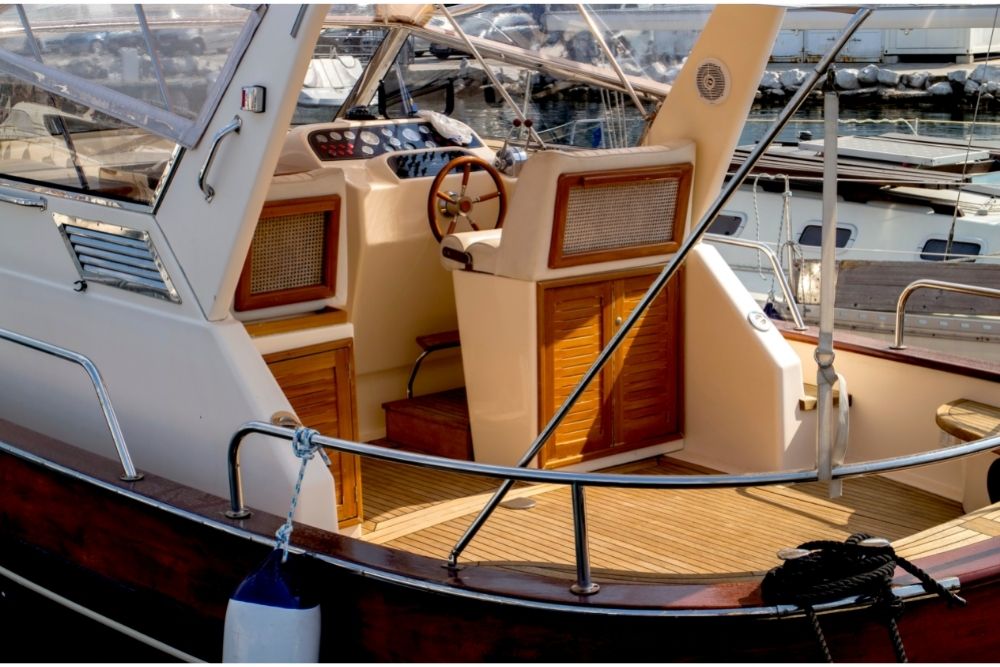When we think about boats, we are usually too enamored with the beauty and glamour of feeling sea-worthy. But, there is one niggling little detail that many of those who take to the waters are trying to fathom.
If you drive a car on a regular basis, you might be wondering, ‘why on earth are boat steering wheels on the right?’
A right-handed steering wheel placement might feel a bit weird, and be a new environment, especially if you spend a lot of time on the road. While some countries do have their steering wheels on the right-hand side in their cars, the states have left-handed steering for their cars.

So, stepping onto a boat after this, and finding the wheel on the right feels pretty peculiar, right?
Knowing the difference between left-hand and right-hand driving is absolutely pivotal to ensure that you can adjust to be able to drive comfortably on your boat. Okay, these differences might take some time to get used to, but understanding the basics is half the battle.
So, not only will we discuss this at length, but we also want to talk about why this steering wheel placement exists in this way.
The Basic Reason
Let’s start off with the basic reasoning for the right-hand steering wheel placement on boats.
The steering wheel is on the right side of power boats for mechanical reasons, as boat propellers spin clockwise and the torque on the propeller causes the right side of older model boat hulls to rise out of the water. Boat designers therefore placed the steering wheel on the right so that the weight of the boat’s operator would keep the boat even in the water.
You do not want it tipping and capsizing, and this is one of the main reasons. It’s partially a weight thing, distributing the weight of the craft evenly so that the boat stays afloat level and not at an angle.
The Origins
But how did this all start? Well, having the steering on the right side of the boat was commonplace long before engines and propellers were even invented. The earlier boats were propelled and steered via paddles.
Right-handed paddlers would naturally steer from the right side of the boat, and since the majority of people are right-handed, steering on the right became commonplace and expected.
Left- Port
In modern day, we know the left-hand side of the ship as being the ‘port-side’. However, in the Middle Ages, Anglo-Saxons used the term as baecbord, which probably came from the fact that sailors sterling the ship had their back facing the left-hand side of the ship.
In later times, sailors would then call the port side ‘larboard’ likely from being known as ‘ladder board’ which is the side on which passengers and cargo would be loaded onboard.
In the 19th century, the term ‘port’ was adopted as the term for the left-hand side of the ship due to confusion between the sounding words ‘starboard’ and ‘larboard’.
Right- Starboard
As larger boats developed in the past, the paddle was slowly replaced by a large oar, which was permanently attached to the right side of the ship. Anglo-Saxon sailors used to call his device the ‘steorboard’ which over time adapted into ‘starboard’.
This manner of steering was eventually placed in the center of the ship’s stern, however, the term starboard stuck and became known as the title for the ship’s right-hand side.
Are Any Boats Left-Handed?
While a vast majority of boats have been crafted with steering wheels being on the right-hand side, there are a few boats which do have their steering on the left. Pleasure crafts and some wooden speed boats will also have steering wheels on the left-hand side.
It is not unheard of for some boats to also have their steering wheel in the center. This placement provides a better overall sea view, and allows the person steering the boat to see any vessel that is approaching.
Traffic obedience is therefore still maintained, as these vessels do not compete with the larger ones overseas.
Is Maneuvering A Steering Wheel For A Boat And Car The Same?

If you are new to boating and the differences between driving a car on the road and a boat at sea, you might wonder if maneuvering a steering wheel for a boat and a car is the same.
Well, the short answer is no, there are some similarities of course, however, there are many differences. Even if you are used to driving a right-handed vehicle, driving a boat is totally different to driving a car.
Aside from the different steering wheel position and location, there are plenty of other differences.
Firstly, the steering wheel control is different in boats than it is in cars. Cars steer in the front, whereas boats steer from the rear, or stern. Steering a car can be pretty simple as when the front tires turn the whole body will follow suit.
On a boat, you need to remember that it swivels around from the rear end, so direct the body of the ship in a way that pushes its stern in an oppositional manner.
Then, you also need to remember that when you are in open water, there will be more hardy winds than on land. The direction of the winds can easily shift a boats’ bow onto a different course.
When you drive a car you do not need to check currents, but in a boat you do, check on the currents as the current can also drag the stern away from the direction you intend to go in.
And finally, do not forget that oversteer is a common problem with new boat drivers. When you drive a car, you steer in your desired direction and just stop at that point, so this makes it easy for boat driving newbies to end up over steering their path.
A car does not take as long to adjust as a boat does. When you drive a car, you see the result of your steering almost immediately, but when you drive a boat, it takes some time before you see the result of your steering.
Boat drives will have to rewind when they exceed the point of their desired turn. Boats are harder to control than a car, there are elements at play, they are not as immediately responsive, and they turn from the back.
So, when you get used to your steering wheel, which may take some time to adapt, you will eventually feel more comfortable than you probably realized you would.
It will take time and practice to feel more comfortable with the steering wheel of a boat, handling your steering wheel with a boat is just as easy as handling steering with your car, It’s just a bit different.
Just like when you are first learning to drive a car, it will take practice and patience, but you will get there in the end.
So, Why Are Boats Right-Handed?
Finally, let’s summarize the answer to this maritime question.
We should also remember when we steer a boat that for the most part most boat traffic will keep to the right-hand side. Before the use of the modern day rudder, boats were steered by a specialized oar (which we mentioned earlier) that was situated on the starboard side of the vessel.
This oar was held by a sailor located toward the stern.
However, direction of traffic and this oar are not the only reasons. Boars would also moor with the left-hand side to the quay to prevent damage being done to the oar that used to steer the boat. Therefore, by keeping the boats port-side to port-side, the boats would protect their steering oars.
Then when modern day rudders came into existence, they were fixed to the stern and the helmsman was moved on the centerline. Then when wheels were replaced by tillers, this stayed the same.
Many motor yachts and smaller crafts are right-hand drive, however, you will still find small wooden speed boats and some smaller pleasure crafts that are built with a left-hand drive to give a better view of passing and approaching traffic.
So, while a majority of boats have right-hand drive, not all of them do. There is a complicated and intricate history behind the right-hand drive we find on boats, but for the most part, it is reasonable and makes sense to do so.
Although we admit it can take some time to adjust to driving a boat on the right-hand side if you are used to cars, and when you are used to driving a boat you want to watch that your habits when driving your car don’t get impacted.
Although boats have a slower response than a car does, and you do not want the muscle memory of slow response transferring into your tarmac traditions, that would be very bad.
So, why do boats have a right-hand drive? Because adaptations through history make it only logical.
